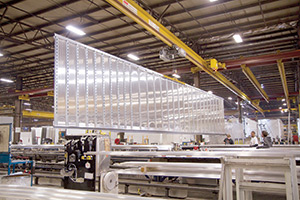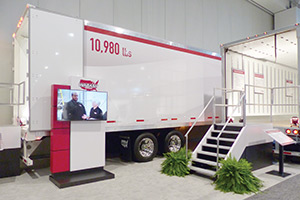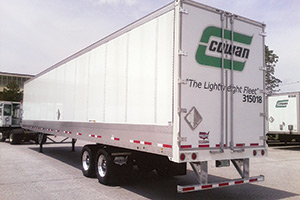Trailer Manufacturers Chip Away at Weight by Using Aluminum, Composite Materials

This story appears in the March 9 print edition of Transport Topics.
Trailer manufacturers have been pursuing weight reduction for years, trimming pounds from body materials and suspension components in response to customer demands for greater hauling capacity.
This has become even more important as emissions technology has added weight to tractors, so trailer makers have been swapping out steel for aluminum, utilizing more composite materials and altering the placement of structural components.
While great strides have been made in cutting weight, fleets and trailer makers caution that those weight savings can have their costs. Sacrifices in longevity and toughness can come with lighter-weight trailers, they said, adding that the trick is finding the right balance.
“If you’re taking weight out, it is because you want to put weight in, so you’re kind of fighting yourself,” said Mark Roush, vice president of engineering at Vanguard National Trailer Corp., based in Monon, Indiana.
“If you take too much out, you start incurring mega-maintenance costs,” added Larry Adkins, field application manager for Wabash National, based in Lafayette, Indiana, “Today, we have customers looking to stretch life cycles out beyond 15 years, [so] when you start making weight reductions, you have to start making your choices carefully.”
Those choices can start, literally, from the ground up.
The “biggest bang for the buck” in trimming trailer weight is in the suspension and wheel ends, which can save 600 to 700 pounds, said Todd Pate, general manager of the southeast region for San Diego-based Hyundai Translead.
Roush added, “The hub-and-drum guys have some lighter-weight options, and you can go from an air-ride suspension to a spring suspension.”
Within the running gear, aluminum hubs can be swapped for steel and cast iron, said Brett Olsen, a spokesperson for Utility Trailer Manufacturing, based in City of Industry, California. “You can save 90 pounds per trailer, and you’re looking at $300,” Olsen said.
Spec’ing disc rather than drum brakes can provide weight savings as well, he said.
“The current configuration for air disc brakes includes an aluminum hub, so by going to disc brakes, we take 125 pounds total out of a tandem axle trailer,” Olsen said, adding that they cost $2,000 or more per trailer.
Even tires can offer savings opportunities, Adkins said, noting that a switch from singles to wide-base tires can result in a decrease of 350 pounds.
Beginning next year, C.R. England, a refrigerated carrier based in Salt Lake City, will begin spec’ing a lighter-weight suspension, said Ron Hall, vice president of equipment and fuel. C.R. England ranks No. 20 on the Transport Topics Top 100 list of the largest U.S. and Canadian for-hire carriers.
“We’re moving to the Hendrickson ULTRAA-K,” he said. While Hall declined to discuss the specific weights of the trailers, he said the company specs lighter-weight trailers as a means to improve fuel economy.
“We know what the fuel economy impact is for each pound of additional weight on a tractor or trailer spec,” Hall said.
There are plenty of options for shaving those pounds. However, manufacturers first must understand the customer’s requirements, what they’ll be hauling and how the load will be carried, Adkins said.
Investing in lightweight trailers is a priority for Steve Silverman, CEO of Raven Transport, based in Jacksonville, Florida. By working with manufacturers, he has developed a beverage trailer that can hold 54,900 pounds of payload — 20% more than trailers he once used — and a dry van that has a 49,000-pound payload, which Silverman said gives him a 10% to 12% advantage over most of his major competitors.
“That has helped us grow our business and become a true transparent partner with our customers,” Silverman said, noting that while some of the lightweight equipment adds cost, customers appreciate that lighter trailers enable Raven to increase hauling capacity and deliver more in each load.
“You’re not tying up the customers’ facilities,” he said.
Wabash’s Adkins said Silverman and others like him are giving manufacturers information that can help them refine the equipment.
“The people who will take anything you can give them and then come back and tell you what works are the heroes of the industry, because they are giving us data you can’t get anywhere else,” Adkins said.
 Wabash Trailer
Wabash TrailerTraditionally, four trailer components — the coupler, undercarriage, landing gear and rear frame — are made of steel, said Adam Hill, vice president of product and sales engineering for Chicago-based Great Dane Trailers. Several manufacturers said they are hesitant to take weight out of those areas.
For example, cross members over the running gear and the landing gear areas, where the weight of the trailer sits when the trailer isn’t hooked to a truck, need to be steel, Hyundai Translead’s Pate said.
“If you take the steel out of those areas, you start to mess with the stability of the trailer,” he said.
Pate noted, however, that steel cross members can be replaced with aluminum in other areas of the trailer, such as the bay area behind the landing gear and suspension, saving a little less than 200 pounds. Utilizing lightweight rear doors shaves off 60 pounds, and opting for aluminum roof bows in lieu of steel saves about 100 pounds.
“We’ve gone as far as putting some additional access holes in the steel upper coupler — you can save an extra 5 or 10 pounds by putting those in,” Pate said.
Olsen said that in a dry van from Utility, switching to aluminum sidewall posts from steel can save around 270 pounds and add less than $100 to the cost.
Vanguard’s Roush said the company can adjust post spacing in certain applications to cut some weight.
Composite materials can provide incremental and major gains. Wabash, for one, has developed composite light-mounting boxes and lightweight license-plate brackets and mud-flap hangers. Wabash also offers a composite nose, which removes the need for a nose post and a plywood liner, saving about 100 pounds.
 John Sommers II for Transport Topics
John Sommers II for Transport Topics“There is no magic bullet,” Adkins said, adding that Wabash often can often squeeze 1,500 pounds out of a trailer.
Dennis Morgan, president of Baltimore-based Cowan Systems, has worked with Wabash to develop trailers that weigh 12,180 pounds, which allows the company to gain 4,000 to 5,000 pounds of payload.
“Your typical trailers in the industry are over 15,000 pounds,” Morgan said, adding that Cowan’s 4,200 trailers are lightweight. Cowan ranks No. 67 on the TT100 for-hire list.
Hyundai’s Pate said the company’s standard 53-foot, air-ride, swing-door composite trailer weighs around 14,100 pounds. “With the correct specifications, I can get a 53-foot composite down to 11,800 pounds,” he said.
C.R. England also has gone to composite scruffs — the bottom 12-18 inches of the wall lining — instead of aluminum.
“We feel it is as strong or stronger, and it weighs less,” Hall said, noting that the carrier avoids adding certain components, such as a lock-strap system to secure loads, because they add weight. “We like the concept, but it is heavy.”
Dave Giesen, vice president of sales and marketing for Stoughton Trailer, based in Stoughton, Wisconsin, said some carriers are opting for smaller equipment to save weight, going to trailers that are 96 inches wide instead of 102 or those that are 48- or 40-feet long instead of 53 feet. They could also opt for a trailer that is 13-feet high instead of 13 feet, six inches.
“We get these requests for specific dedicated lanes, products or accounts,” he said, adding that they get the request on about 2% of quotes.
On a traditional dry van, Giesen said that Stoughton can cut about 1,800 pounds out of a trailer while keeping industry standard floor ratings and the gross vehicle weight rating. “This weight can be reduced even further if floor ratings can be reduced,” he said.
Morgan said Cowan tried aluminum floors, which can save more than 350 pounds, but found they didn’t work for the company. “The screws that went through the floor to the cross members got loose, and you had to tighten them,” he said. Morgan now specs composite floors with aluminum strips on the side.
Olsen noted that aluminum floors can present challenges. “Aluminum doesn’t move and flex like wood does, so there are going to be some maintenance issues,” he said.
Roush said swapping out a wood floor to a composite floor can save 500 pounds.
Mike Jeffress, vice president of maintenance for Maverick USA Inc., a flatbed carrier in Little Rock, Arkansas, went to manufacturers several years ago and asked them to pull 1,000 pounds out of a trailer.
“There is a laundry list of items you have to go through spec by spec,” he said. “We challenged the manufacturers on how the suspensions and different components could be changed.”
Maverick ranks No. 80 on the for-hire TT100.
In some cases, Jeffress, like Morgan, found some things didn’t work, such as certain fasteners holding a suspension to the mainframe.
“We’ve experienced some minor problems and had to try and beef that up,” Jeffress said. “It is a partnership that we try to work with any particular supplier on, and sometimes we say we might have missed the boat. When you take weight out, that does affect durability and longevity of the product, so you have to ascertain how that is going to affect your cost structure.”
Utility surveyed dry van carriers and found that 70% cubed out before they weighed out, which Olsen said shows weight is less of an issue for dry van carriers.
Those in the refrigerated market tend to be more concerned with weight, Olsen said, adding that there are different approaches to removing weight based on the trailer type.
Utility’s refrigerated trailer uses a single process where the roof, walls and floor are built in one piece with foam. Then, insulation is injected inside.
“Our pieces don’t have to support any weight except their own weight, which means they can be lighter,” Olsen said.
Changing the insulation can reduce weight on reefers. Going to a 2-inch floor insulation from 3 inches saves 80 pounds, changing the roof insulation to 2 inches from 3 can save 62 pounds and switching to 1½-inch sidewalls from 2-inch sidewalls can save
 Cowan Systems
Cowan Systems55 pounds. However, thinner walls won’t insulate as well.
Hill said that in addition to upfront weight savings achieved by material selection, there can be longer-term weight savings. In reefers, liners make the units more resistant to water vapor permeation through the liner into the foam insulation. Overall, composite materials resist water weight gain over time since they don’t absorb water as traditional wood materials do.
Carriers that are investing in the technology said they can justify the cost. While Cowan’s Morgan knows the lightweight trailers he purchases come with a higher price tag, he said he has been spec’ing lightweight materials for so long, he doesn’t know exactly how they compare with standard trailers.
“My gut is that it is probably on the high side of $1,500 to $2,000 more,” he said. “Our experience has been that you don’t get a higher rate because you can haul more freight. But, you get an opportunity to bid on more freight.”
Hall said, “It all comes down to cost benefit. What are you willing to pay to get the weight out of the system?”

